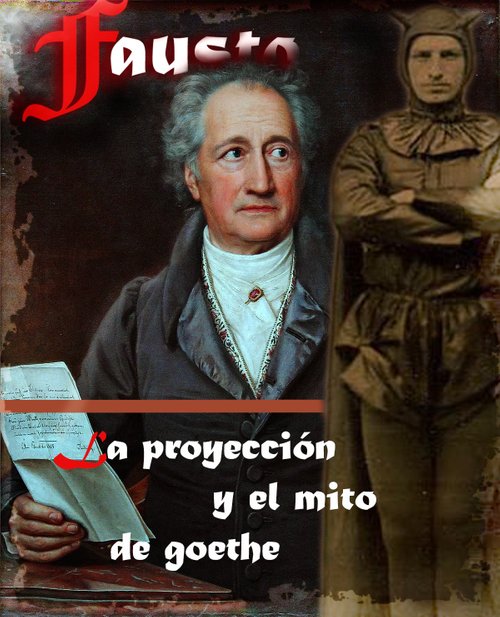Faust, the projection and myth of Goethe | Fausto, la proyección y el mito de Goethe.
The Faust of Goethe, in the extensive elaboration through the years tells us the experiences and imagination of that of the author himself. Throughout his life, this tragedy reflected the way of seeing his secret aspiration, and although Faust is not simply a common myth. It is a way of expressing the symbol of man, that tireless being who dominates the world and matter with force and efficiency.
In other words, the work of Johann Wolfgang von Goethe, is a myth that is maintained over time as an explosive reflection of the unconscious.
Symbolically, through our history. We will find the figure of the man "faust" who becomes a necromancer to dominate the powers of nature, disfiguring power towards machismo that, due to its dualism and ingrained characteristics, projects the cultural facet of the carnal man.
We find ourselves in front of a representation of the divine trinity: the magician, the maiden and the devil. In this trinity, good fights against evil, and in Goethe's Faustian paradox this "Faustian man" is the aspiration for perfection and the search for persistent nonconformity, the desire that forces men and women to cross all barriers and try to ascend to the heights.
These functions can be seen in the living being that maintains its existence, observing the world in such a way that beyond, being a habit or an attitude, it is a position of the human being that struggles from birth to achieve an achievement, to increase its power, his vanity or his influence.
Mephistopheles.
First of all, Mephistopheles. The name of the devil in Faust's work derives, according to some from the Greek Photophilos, with the negative prefix it would come to mean: the enemy of light. The same as Lucifer, the negative representation of God. Although Mephistopheles is a mocking deity, it is the impetuous and dark wisdom of the subconscious, around a dark figure that ends in the emergence of light or rather knowledge.
This work by its author, describes impressively the mutual sympathy that seems to exist between God and the Devil; in the dialogue that they engage in in the prologue of heaven. This elaborate thesis seems to be represented in the rich tradition that throughout history in religions has presented divinity as a double: benign and evil, masculine and feminine, kind and cruel.
The work of life.
Adaptation of the preliminary test: Juan Rof Carballo.
Great universal classics book: Johann Wolfgang Goethe, Faust.
1982

Faust, the projection and myth of Goethe | Fausto, la proyección y el mito de Goethe.
USED PROGRAMS: Adobe Photoshop CC 2017 / PROGRAMAS USADOS: Adobe Photoshop CC 2017 .
Goethe, el personaje.
El fausto de Goethe, en la extensa elaboración a través de los años nos cuenta las experiencias e imaginación de su mismo autor. Durante toda su vida, esta tragedia reflejo el modo de ver su aspiración secreta, y aunque Fausto no es sencillamente un mito común.Es un modo de expresar el símbolo del hombre, aquel ser incansable que domina el mundo y a la materia con fuerza y eficacia.
Es decir la obra de Johann Wolfgang von Goethe, es un mito que se mantiene en el tiempo como una reflexión explosiva del inconsciente.
Simbólicamente, a través de nuestra historia. Nos encontraremos con la figura del hombre “fausto” quien se convierte en un nigromante para dominar los poderes de la naturaleza, desfigurando el poder hacia el machismo que por su dualismo y características arraigadas, proyecta la faceta cultural que tiene el hombre carnal.
Nos encontramos frente a una representación de la divina trinidad: el mago, la doncella y el demonio. En esta trinidad el bien lucha contra el mal, y en una paradoja fáustica de Goethe este “hombre fáustico” es la aspiración a la perfección y la búsqueda del inconformismo pertinaz, el anhelo que obliga a hombres y mujeres en franquear todas las barreras y tratar de ascender a las alturas.
Estas funciones se pueden ver en el ser vivo que mantiene su existencia, observante del mundo en modo que más allá, de ser un habito o una actitud, es una posición del ser humano que lucha desde que nace en alcanzar un logro, por aumentar su poderío, su vanidad o su influencia.
Mefistoteles.
En primer lugar, Mefistófeles. El nombre del diablo en la obra de Fausto deriva, según algunos del griego Photophilos, con el prefijo negativo vendría a significar: el enemigo de la luz. Lo mismo que lucifer, la representación negativa de dios. Aunque Mefistófeles es una deidad burlona es la impetuosa y oscura sabiduría del subconsciente, alrededor de una figura tenebrosa que concluye en el surgimiento de la luz o mejor dicho el conocimiento.
Esta obra de su autor, describe impresionando la mutua simpatía que parece existir entre Dios y el Diablo; en el dialogo que entablan en el prólogo del cielo. Esta tesis elaborada que parece representarse en la rica tradición que a lo largo de la historia en las religiones ha presentado la divinidad como dúplice: benigna y maligna, masculina y femenina, bondadoso y cruel.
La obra de la vida.
Adaptación realizada del ensayo preliminar: Juan Rof Carballo.
Libro grandes clásicos universales : Johann Wolfgang Goethe, Fausto.
1982

Follow
─────────────────────♡─────────────────────
Resources | Recursos
